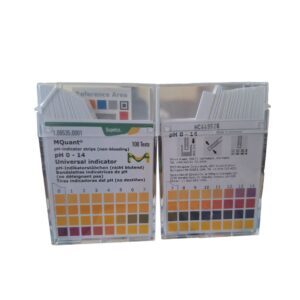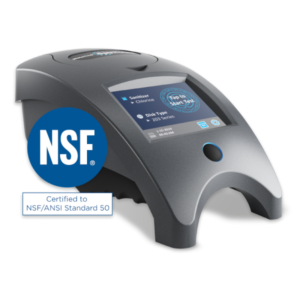BioPaddles® – Nutrient-TTC Agar (NUT-TTC) & MacConkey Agar (MAC)
AED 0.00
Product ID: 5553
The BioPaddles® NUT-TTC/MAC uses Nutrient-TTC Agar (NUT-TTC) MacConkey Agar (MAC) for the isolation and differentiation of Gram (-) enteric bacilli. Coliform Testing / Recovery of Stressed Coliforms.
NOTE: No Exchange No Return Learn More
Warranty: Not applicable, except in cases of wrong or damage item delivery. In such instances, we will replace the product upon receipt of proof in the form of videos and photos.
Quality comes first and our products deliver accurate results.
Nutrient-TTC Agar (NUT-TTC)
General purpose relatively non-selective agar medium, containing two peptones, which will support the growth of a wide variety of organisms. Suitable for cultivation of both of aerobes and anaerobes. This medium contains the dye, 2, 3, 5- triphenyltetrazolium chloride (TTC) . Aerobic coliform bacteria species grow on this medium and can be detected by their ability to reduce TTC to a red colored formazan dye. Bacterial colonies appear as red dots on an otherwise clear yellowish medium. Agar is the solidifying agent.
MacConkey Agar (MAC)
Both selective and differential; used to differentiate between Gram negative bacteria while inhibiting the growth of most Gram positive bacteria. The medium also differentiates between lactose-fermenting coliforms Lac (+) and lactose non-fermenters Lac (-), which include potential pathogens. Addition to the nutrient agar base of bile salts and crystal violet will inhibit the growth of most Gram-positive bacteria, making MacConkey agar selective. Lactose, a fermentable carbohydrate, and neutral red, a pH indicator, are added to differentiate the lactose positive coliforms from the potentially pathogenic lactose non-fermenters. When lactose is fermented, acid products lower the pH below 6.8, with the resulting colonial growth turning pinkish-red. If an organism is unable to ferment lactose, the colonies will be colorless. Bile salts mixture and crystal violet are the selective agents, inhibiting Gram positive cocci and allowing Gram-negative organisms to grow. Sodium chloride maintains the osmotic environment. Agar and a proprietary polymer are the solidifying agents.
Application
In total coliform testing (TCC), the coliform organisms tested for include: total coliform, fecal coliform, and E. coli (Escherichia coli). Detection of fecal coliforms (a subset of total coliforms) or Escherichia coli (a subset of fecal coliforms) can indicate the potential presence of waterborne pathogens associated with fecal contamination.
BioPaddles® – Nutrient-TTC Agar (NUT-TTC) & MacConkey Agar (MAC)
| Test Factors | E. coli & Coliforms |
| Type of Agar(s) | Nutrient TTC/MacConkey Agar |
| # of Tests | 10 |
Storage/Expiration
Store tightly sealed BioPaddles® in a cool, dry location. Shield from direct sunlight. Store BioPaddles® at room temperature (65 to 77°F/18 to 25°C). Avoid sudden temperature changes. Temperature fluctuations may result in condensation settling at the bottom of the vial. This will not affect the culture properties, but could reduce the shelf-life or cause the agar to separate from the plastic paddle support. Do not refrigerate. Refrigeration may result in water condensation. Avoid freezing. If freezing occurs, thaw for 3-6 hours in the refrigerator (40°F; 4.4°C). Freezing can promote excess water loss and variation in media surface due to crystal formation. Refer to Best Before End date (See: BBE stamped on vial). Discard if paddle agar appears oxidized and darker than the expected color or if contaminants appear. The expiration date is based on medium in an intact container that is stored as directed.
Sampling
Liquids: Twist to remove paddle from vial. Fill vial to 40 mL fill line with the liquid to be sampled. The 40 mL volume can be used to calculate Total Viable Count (TVC) and/or Total Colony Count (TCC). Replace paddle. Allow a contact time of 15 seconds. Remove the paddle. Empty the vial. Replace the paddle in the vial.
Surfaces: Twist to remove paddle from vial. Allow the paddle surface (10 cm2) to come into physical contact with the test surface. Recovery rate is about 50%. To ensure an accurate recovery, gently sweep (or touch) the paddle to cover a 20 cm2 area. Replace paddle in vial.
Incubation
Incubate at 35 ±2°C for 18-24 hours.
Colony Measuring
Each BioPaddles® paddle has molded media attachment points that are 4mm in length (point-to-point). This feature provides a useful guidepost to estimating nearby colony size.
Disposal
Twist to remove paddle from vial. Fill vial to 40 mL fill line with 1:9 dilution of household bleach (5.25% sodium hypochlorite). Replace paddle in vial. Allow 15 minute contact time. Remove paddle. Discard bleach solution. Replace paddle in vial and dispose. Alternatively, loosen cap and microwave for 30 seconds, autoclave, or incinerate.
Ship Code: (NH) Non-Hazardous Material – No Fees Applicable
Ship Weight in lbs.: 1
Related products
Water Testing Strips & Instrument
Water Testing Strips & Instrument
Water Testing Strips & Instrument
Water Testing Strips & Instrument
Water Testing Strips & Instrument
Water Testing Strips & Instrument
Water Testing Strips & Instrument
Tracer Electronic Meters














